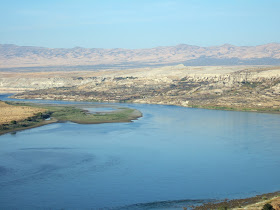Lake Padden watershed and urban growth
Urban growth areas are areas that are designated under the Washington State Growth Management Act as areas that will be urbanized in the future. One of Bellingham's designated growth areas is in the Lake Padden watershed. The city has had growth expansion plans for this area that date back well before the Growth Management Act. The area was designated for growth under the Growth Management Act by the City of Bellingham in 1997. In 1997 Whatcom County approved the City's growth plans.
This growth area has created some dilemmas. Although approved in 1997 by Wahtcom County, periodically the growth boundaries must be reviewed and updated. During the update process in 2007 questions began to be raised by the county regarding the Lake Padden area. Specifically, Did the city have a capital facilities plan for providing urban services to the area? This is an important aspect of the Growth Management Act. It is the conservative part of the Act. The part that should protect tax payers and utility rate payers. Capital Facility Plans should answer the questions about how will the roads, fire and police service, water service, schools, sewer service and more recently stormwater management be paid for. Something every good fiscal hawk should be concerned about.
The Lake Padden area is a tough nut under the Growth Management Act. There have been development schemes in the works for this area for a long time - long before the Growth Management Act came along in the early 1990s. But regardless of the original schemes for this area being urbanized, the area does not match well with the goals of the growth management act. Urbanizing this area is going to be expensive. Thus far most of the urbanization efforts in the area have been heavily subsidized with much of the money coming in the form of federal and or state grants for road improvement projects and the construction of an elementary school.
These partial urbanization efforts combined with the years of the area being considered a future growth area has created an area that falls into the cracks of Growth Management controversy. It turns out that it is really really hard for cities and counties to say, "You know what, we need to rethink this plan for urban growth; it doesn't look like it is working out very well."
Back in 2007, the City of Bellingham had proposed dramatically increasing the density around the lake. This was done in part to try to make the capital facilities costs work out. The City Planning Commission had said yes. The City Council had said yes. The County Planning Commission had said yes, but with somewhat less density which made City officials unhappy. I had been following the process for a while and had gone to a City Council meeting when a member of the public wondered if it was a good idea to urbanize the Lake Padden watershed. I don't know who that citizen was, but I pulled up a topographic map the next day.
Topo of Lake Padden watershed
Right away I noticed that lake has a very small watershed. Hence, this lake could easily turn into the equivalent of a large storm water pond. The city was proposing putting high density housing in at least 40% of the watershed. The Environmental Impact Statement for the proposed city growth plan noted that there were already water quality issues in the lake and in the stream downstream of the lake. So it was suggested that perhaps not only should the higher density proposal for this area be rejected, but that the size of the urban growth area in the watershed be shrunk. The majority of the County Council members thought the idea was a good one. At the time there were pending subdivisions in the watershed so it made no sense to pull the growth area back all the way back, but the growth plans were pulled back.
But that was only the beginning of the Lake Padden issue. Due to a variety of complex Growth Management Act planning issues that had nothing to do with Lake Padden, the whole Bellingham growth plan had to be reviewed again two years later.
A couple of changes had taken place since the 2007. First the two large subdivisions that had been planned for the watershed failed to become final and were no longer vested. Their problem was they were unable to get water service due to the high costs of building a new water tank and lines into the area combined with the fact the City of Bellingham won't extend water lines unless an area is going to be annexed into the city. The developers had applied to be annexed, but the city rejected the annexation proposal because adding the area into the city was going to be very expensive - think roads, water lines, sewer, police, fire. It was now clear that the city could not afford passing the costs of the capital facilities onto city tax payers and utlity rate payers in a fair manner.
Whatcom County Planning did something during the new review process that they had not previously done. The County demanded that each city provide a capital facilities plan for all proposed growth areas including ares that had been previously designated. This is a requirement under the State Growth Management Act. For the Lake Padden watershed area, it became clear that the city did not have a viable plan for funding the needed projects to support this area as an urban area. Hence, the County placed this area into a reserve status.
The developers of the area did not like this so they filed an appeal to the Western Washington Growth Management Hearings Board. This board settles disputes between parties on growth planning issues under the Growth Management Act. At least some members of the County Council are sympathetic to the developers and have put forward the idea of putting this area back in urban growth area status. Its the old argument that is a constant issue on growth planning under the Growth Management Act - it is hard to back away from past growth plans no matter how bad they might be.
Much attention is being directed at the County Council on this issue, both by development proponents and those that question the wisdom of developing without capital facilities planned.
But it is an interesting dilemma for the County Council. The message from the City of Bellingham has been mixed. You see, Bellingham has left this area in their own growth plans. Hence, when the developers appeal the county taking the area out of the City of Bellingham Growth Area, it is the county that must defend that decision. And the developers will be sure to point to the fact that the city still includes the area in its growth plans. If the County puts the area back in the City Growth Area, that decision will surely be appealed as well. Based on the lack of capital facilities plans as well as some other significant issues, there is very likely little chance that Lake Padden area will be designated a growth area.
During recent County Council deliberations a County Council Member stated that this area as a growth area is just common sense. I do not think he meant that those that thought it was a bad idea lacked common sense, but development in this area may not make that much sense. Without a plan for how to pay for all the urban streets, fire service, police service, water lines, sewer lines and stormwater management it really is a bit too early to tell if growth in this area is common sense or not.
Stormwater impacts are a part of the challenge of this area. That is for another wonky post. But, it may be time for the City of Bllingham to take another look at their urban growth plans even though the law does not require an update until 2016. Otherwise the issues around Lake Padden will linger for years to come in a manner that may be unfair to everybody.






















































